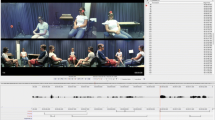Abstract
This study examined the verbal and nonverbal behaviors which characterize the ends of two-person face-to-face interactions. It was hypothesized that sequences of both verbal and nonverbal behavior would be present in conversational endings and that nonverbal behaviors would occur with different frequency in the middle and at the end of conversations. It was also predicted that both verbal and nonverbal behavior in conversational endings between friends and between strangers would differ. Ten dyads of friends and ten dyads of strangers, all female, were videotaped while in relatively unconstrained conversation. The content of verbal statements and the occurrence or nonoccurrence of 13 nonverbal behaviors in the ten middlemost and the ten last turns were analyzed. Results indicated that the seven verbal statement types formed a sequence of information, summary, question, verbalization, justification, continuity, and well-wishing. Six clusters of nonverbal behavior distinguished the ending phase from the middle phase; these behaviors were organized into a general sequential pattern, but the positions of several behaviors within the sequence were subject to variation. Finally, three clusters of nonverbal behaviors (more looking away, more grooming, less head nodding) distinguished conversation endings between friends from those between strangers.
Similar content being viewed by others
References
Albert, S. & Kessler, S. Ending social encounters.Journal of Experimental Social Psychology 1978,14 541–553.
Bales, R. E.Interaction process analysis: a method for the study of small groups. Reading, Massachusetts: Addison-Wesley, 1950.
Duncan, S. Jr. Toward a grammar for dyadic conversation.Semiotica 1973,9 29–46
Duncan, S. Jr. & Fiske, D. W.Face-to-face interaction: research, methods, and theory. Hillsdale, NJ: Lawrence Erlbaum, 1977.
Duncan, S. Jr., Brunner, L. J., & Fiske, D. W. Strategy signals in face-to-face interaction.Journal of Personality and Social Psychology 1979,37 301–313.
Fleiss, J. L. Measuring agreement between two judges on the presence or absence of a trait.Biometrics 1975,31 651–659.
Erickson, F. One function of proxemic shifts in face-to-face interaction. In A. Kendon, R. Harris, & M. R. Key (Eds.),Organization of behavior in face-to-face interactions. The Hague: Mouton, 1975.
Gallois, C. & Markel, N. N. Turn-taking: social personality and conversational style.Journal of Personality and Social Psychology 1975,31 1134–1140.
Goffman, E.Relations in public. New York: Basic Books, 1971.
Gottman, J. M. & Bakeman, R. The sequential analysis of observational data. In M. E. Lamb, S. J. Suomi, & G. R. Stephenson (Eds.),Social interaction analysis: Methodological issues. University of Wisconsin Press, 1979.
Jaffe, J. & Feldstein, S.Rhythms of dialogue. New York: Academic Press, 1970.
Johnson, S. C. Hierarchical clustering schemes.Psychometrika 1967,32 241–254.
Kendon, A. The F-formation system: the spatial organization of social encounters.Man-Environment Systems 1976,6 291–296.
Kendon, A. & Ferber, A. A description of some human greetings. In R. P. Michael & J. H. Cook (Eds.),Comparative ecology and behavior of primates. London: Academic Press, 1973.
Knapp, M., Hart, R., Friedrich, G., & Shulman, G. The rhetoric of goodbye: verbal and nonverbal correlates of human leave-taking.Speech Monographs 1973,40 182–198.
Krivonos, P. D. & Knapp, M. L. Initiating communication: what do you say when you say Hello?Central States Speech Journal 1975,26 115–125.
La France, M. & Mayo, C. Racial differences in gaze behavior during conversations: two systematic observational studies.Journal of Personality and Social Psychology 1976,33 547–552.
Lockard, J. S., Allen, D. J., Schiele, B. J., & Wiemar, M. J. Human postural signals: stance, weight-shifts, and social distance as intention movements to depart.Animal Behavior 1978,26 219–224.
Markel, N. N. Coverbal behavior associated with conversation turns. In A. Kendon, R. Harris & M. R. Key (Eds.),Organization of behavior in face-to-face interaction. The Hague: Mouton, 1975.
Mehrabian, A. Verbal and nonverbal interaction of strangers in a waiting situation.Journal of Experimental Research in Personality 1971,5 127–138.
Mehrabian, A. & Ksionzky, S. Some determiners of social interaction.Sociometry 1972,35 588–609.
Prebor, L. D.The natural history of a conversation. Unpublished Doctoral Dissertation, University of Florida, 1972.
Riggio, R. E., Friedman, H. S., & DiMatteo, M. R. Nonverbal greetings: effects of the situation and personality.Personality and Social Psychology Bulletin 1981,7 682–689.
Schegloff, E. A. Sequencing in conversational openings.American Anthropologist 1968,70 1075–1095.
Schegloff, E. A. & Sacks, H. Opening up closings.Semiotica 1973,8 289–327.
Summerfield, A. B. & Lake, J. A. Non-verbal and verbal behaviors associated with parting.British Journal of Psychology 1977,68 133–136.
Author information
Authors and Affiliations
Additional information
We are grateful to Helen McKenna and Peter Pamment for their help. We also appreciate the comments given by Dr. Judee, K. Burgoon, and an anonymous reviewer.
Rights and permissions
About this article
Cite this article
O'Leary, M.J., Gallois, C. The last ten turns: Behavior and sequencing in friends' and strangers' conversational findings. J Nonverbal Behav 9, 8–27 (1985). https://doi.org/10.1007/BF00987556
Issue Date:
DOI: https://doi.org/10.1007/BF00987556




